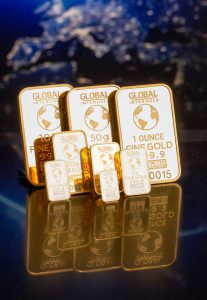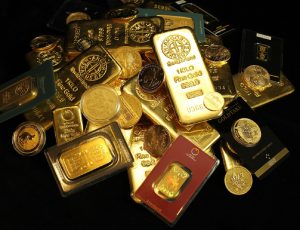 For many years, economists have been warning us about the likelihood of a collapse of the monetary system and the total loss of confidence in currencies. The gold standard will then be the only valid option to save our economies.
For many years, economists have been warning us about the likelihood of a collapse of the monetary system and the total loss of confidence in currencies. The gold standard will then be the only valid option to save our economies.
This assertion takes on even more meaning following the posting of a text on the DNB (De Nederland Bank) website. The Central Bank of the Netherlands certifies that “if the system collapses, the stock of gold can serve as a basis for rebuilding it. Gold creates confidence in the stability of the central bank’s balance sheet, it creates a feeling of security”.
The DNB adds “Gold is the anchor of confidence in the financial system. If the whole system breaks down, the gold stock provides a guarantee to start from scratch. Gold boosts confidence in the strength of the central bank’s balance sheet.
Here we see that Gold can secure a global economic system. It is a powerful and real base. Gold allows a country to stay upright in the event of a monetary collapse and that is why many central banks invest in the safe haven.
If the grim forecasts of the fall of the currency are not a novelty, it is rare that a Central Bank speaks so freely about it and even more to recommend to the general public to invest in Gold. Indeed, it is rather exceptional for a traditional financial institute to evoke the superiority of gold compared to a still healthy monetary asset.
The Central Bank of the Netherlands, therefore, admits that Gold is the only global reference value.
Prevention Is Better Than Cure!
Central banks have always invested in gold, a safe haven par excellence. In recent years, we have seen an increase in the purchase of gold by these large banks to protect themselves from a new crisis.
The Central Bank of the Netherlands has 615 tons of gold stored largely in Amsterdam but also in the United Kingdom and North America.
However, the majority of his gold stock will be transferred to his new vault located in a military building in Zeist.
Is the country preparing for financial collapse by moving its assets into gold?
We’ve been asking you this question for a few years now. We have observed and demonstrated that the central banks of the world have increased their gold stocks. We can cite China, India, Japan, Russia, Hungary, or even Kazakhstan.
If these great powers invest heavily in gold, we can deduce that a financial cataclysm is about to happen. Central banks around the world buy gold to protect their economy.
Think about it and see if your savings are actually safe in your Bank or not. Gold is THE safe haven par excellence and is therefore an investment whose value is maintained or even increased in the event of a financial crisis. It is independent of other assets (bonds, shares, etc.) which may collapse in times of economic and political instability.
Our precious metals experts are at your disposal and can assist you in your process of buying gold.
What Could 2023 Hold For Gold And Silver?
As we enter 2023, there is much speculation on what the future holds for the precious metals market, particularly gold and silver. The global economic landscape, geopolitical tensions, and fluctuations in demand and supply all contribute to the volatility of precious metals prices. In this blog post, we will explore some of the factors that could impact gold and silver prices in 2023.
Global Economic Landscape
The global economic landscape is one of the most significant factors that could impact gold and silver prices in 2023. Several economic indicators, such as GDP growth, inflation, and interest rates, play a crucial role in determining the value of precious metals. In 2022, the world saw a sharp rise in inflation and a significant increase in central bank interest rates to combat it. In 2023, we could see central banks maintain or even raise interest rates further to tackle inflation, which could potentially weaken the demand for precious metals.
Moreover, the economic policies adopted by governments worldwide could also have an impact on gold and silver prices. For instance, increased government spending on infrastructure projects could lead to increased demand for commodities, including precious metals. On the other hand, government policies that restrict imports and exports could lead to fluctuations in supply and demand, leading to price volatility.
Geopolitical Tensions
Geopolitical tensions are another significant factor that could impact gold and silver prices in 2023. Tensions between major global powers, such as the US, Russia, and China, could lead to increased uncertainty and volatility in the financial markets, including the precious metals market. Furthermore, tensions in the Middle East or other regions could lead to disruptions in the supply chain, causing a surge in demand for precious metals.
Fluctuations In Demand And Supply
Fluctuations in demand and supply are perhaps the most significant drivers of precious metals prices. In 2022, the global demand for precious metals remained relatively stable despite the COVID-19 pandemic. However, supply disruptions due to mining shutdowns and labor shortages resulted in price volatility. In 2023, we could see mining companies struggle to ramp up production to meet demand, resulting in further price increases.
In addition, the rise of green technologies could also impact the demand for precious metals. Technologies such as solar panels, electric vehicles, and battery storage systems require significant amounts of silver, copper, and other precious metals. As the demand for green technologies grows, we could see a surge in demand for precious metals, potentially driving up prices.
 Monetary Uses And More
Monetary Uses And More
In addition to its reputation as a safe haven, gold also has significant monetary uses. Central banks around the world hold significant amounts of gold reserves, and gold is still used as a form of currency in some countries. In 2023, we could see central banks continue to add to their gold reserves as a hedge against inflation and economic volatility.
Furthermore, gold is also widely used in the jewelry industry. With the global economy expected to continue to recover in 2023, demand for luxury goods such as gold jewelry could increase, potentially driving up the price of gold.
Silver: The Metal Of The Future
While gold has a long history as a monetary asset, silver is often referred to as the “metal of the future.” This is due to its increasing use in a variety of modern technologies, including solar panels, electric vehicles, and 5G networks. In 2023, we could see the demand for silver increase as these technologies become more prevalent, potentially driving up the price of silver.
In addition to its industrial uses, silver is also a popular investment option for individuals and institutions. Its lower price point compared to gold makes it more accessible to a wider range of investors. In 2023, we could see increased demand for silver from investors looking to diversify their portfolios.
Conclusion
In conclusion, several factors could impact gold and silver prices in 2023. The global economic landscape, geopolitical tensions, and fluctuations in demand and supply all contribute to the volatility of the precious metals market. While it’s impossible to predict the future, keeping an eye on these factors can help investors make informed decisions when it comes to investing in gold and silver.
